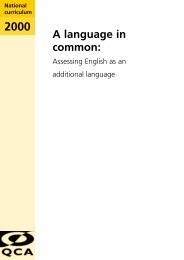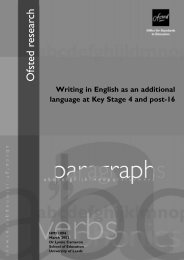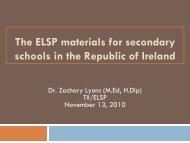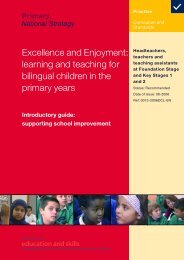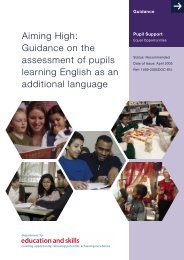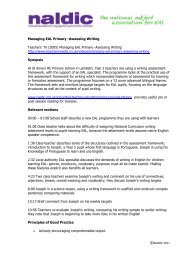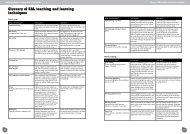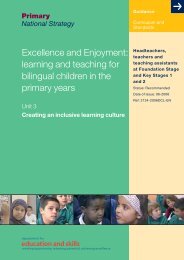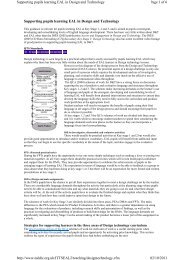Supporting Language and Cognitive Development - NALDIC
Supporting Language and Cognitive Development - NALDIC
Supporting Language and Cognitive Development - NALDIC
You also want an ePaper? Increase the reach of your titles
YUMPU automatically turns print PDFs into web optimized ePapers that Google loves.
http://www.naldic.org.uk/ITTSEAL2/teaching/<strong>Supporting</strong><strong>Language</strong><strong>and</strong><strong>Cognitive</strong>deve...Page 1 of 302/10/2011<strong>Supporting</strong> <strong>Language</strong> <strong>and</strong> <strong>Cognitive</strong> <strong>Development</strong>In responding to the individual learning needs of bilingual pupils, it is important that linguistic development beintegrated with other kinds of learning. Learners require English to communicate with peers <strong>and</strong> teachers <strong>and</strong> tocontinue the process of conceptual development within the context of an English medium school. Thomas <strong>and</strong>Collier (1997, 2000) have symbolised the relationship between the socio-cultural, linguistic <strong>and</strong> cognitivedimensions of language acquisition as a multi-dimensional prism with the learner at its centre, surrounded by thesocial <strong>and</strong> cultural processes of everyday life which have impact on the cognitive, academic <strong>and</strong> language domainsof development . Within a supportive socio-cultural environment, the language, cognitive <strong>and</strong> academic dimensionsmust develop together in an interdependent way – ‘If one is developed to the detriment of another, this may bedetrimental to a students’ overall growth <strong>and</strong> future success’ (Thomas <strong>and</strong> Collier, 1997, p.21).Scaffolding <strong>Language</strong> LearningA key idea in helping learners to construct meaning derives from Vygotsky’s work (1962). He described learning asa cooperative venture where negotiation of meaning is more important than transmission of knowledge. A centralconcept in his work is the Zone of Proximal <strong>Development</strong> (ZPD) - the distance or cognitive gap between what thelearner can do without help <strong>and</strong> what the learner can do with the collaboration <strong>and</strong> support of a more skilled expert.Thus, teachers intervene with learners in a joint construction of knowledge by challenging <strong>and</strong> extending theircurrent level of development, using their existing repertoire of skills <strong>and</strong> knowledge but providing a supportivescaffold so that the learner is able to move to the next stage within his or her ZPD. This scaffolding metaphor is acrucial one in relation to EAL pedagogy. Vygotsky suggests that the only ‘good’ learning is learning that is ahead ofactual development. Gibbons (2002) argues that ‘it is only when teacher support – or scaffolding – is needed thatlearning takes place, since the learner is then likely to be working within his or her zone of proximaldevelopment’ (p.10). If this does not take place, therefore, the learner will be perpetually operating within his or hercomfort zone <strong>and</strong> will not move from what is known to what is new learning. In this collaboration, the talk thataccompanies joint problem-solving is important in providing a resource for thinking. Collaborative learningactivities can also be designed to stimulate the kind of pupil-teacher, or pupil-pupil, dialogue that supportsexplorative talk <strong>and</strong> the acquisition of English language skills in a cognitively dem<strong>and</strong>ing yet linguistically <strong>and</strong>socially supportive situation. For an example of a collaborative learning activity designed to support the developmentof talk see this Macbeth vignette. Where learners are involved in an apprenticeship relationship with a moreexperienced peer or adult, undertaking joint involvements to solve problems <strong>and</strong> carry out tasks – the notion of thecollaborative co-construction of knowledge – effective language learning will be enhanced.The Knowledge FrameworkIf EAL learners are to catch up academically with their peers, cognitive growth <strong>and</strong> mastery of academic contentmust continue while English is being learnt. Thus the learning <strong>and</strong> teaching of EAL must be integrated with thelearning <strong>and</strong> teaching of other academic content that is appropriate to learners’ cognitive level. By the same token,subject teachers need to take on a role in teaching language. Mohan (1986) provided a theoretical framework forsuch an approach. In his model, content <strong>and</strong> language objectives need to be integrated across the curriculum in asystematic way. This approach is referred to as the ‘Knowledge Framework’, which is made up of six majorstructures of knowledge: classification, principles, evaluation, description, sequence <strong>and</strong> choice. Each of theseknowledge structures links to the specific types of thinking skills involved in a particular activity, <strong>and</strong> has unique <strong>and</strong>distinct linguistic features setting it apart from the others. Mohan also argued that the knowledge structures could berepresented graphically by ‘key visuals’ such as graphs, tables, flowcharts, etc. that have reduced linguistic dem<strong>and</strong>sbut organise information in a format that assists underst<strong>and</strong>ing of concepts <strong>and</strong> helps to develop related languageskills.The role of the first languageFirst language development will have a significant impact on both second language learning <strong>and</strong> cognitivedevelopment. (see Bilingual <strong>Language</strong> Acquisition ). Research into bilingualism tells us that a bilingual learner isable to draw on existing knowledge <strong>and</strong> awareness of the structure <strong>and</strong> functions of language, <strong>and</strong> that first languagedevelopment supports the learning of the second or additional language. Bilingual learners are able to transferknowledge <strong>and</strong> skills between languages, using the ‘common underlying proficiency’ whereby aspects of proficiencyin first <strong>and</strong> second language are interdependent <strong>and</strong> actively used across languages. Cummins (2001) represents thisas a ‘dual iceberg’ in which the surface features of each language, for example pronunciation, syntax etc., are verydifferent but are being processed by a single system so that content <strong>and</strong> skills learned through one language willtransfer to another. Continuing development of both languages seems to support enhanced cognitive, linguistic <strong>and</strong>academic growth. Indeed, longitudinal research into long-term fully bilingual educational programmes (Collier
http://www.naldic.org.uk/ITTSEAL2/teaching/<strong>Supporting</strong><strong>Language</strong><strong>and</strong><strong>Cognitive</strong>deve...Page 2 of 302/10/20112000) has shown that two-way bilingual education at primary school level is the most effective model of provisionfor the long-term academic achievement of EAL learners.(see research summary)Jill Bourne (DfES 2002) stresses the value of pupils’ bilingual skills in the Literacy Strategy’s guidance on homelanguages in the literacy hour, which provides background information on bilingualism <strong>and</strong> some practical strategiesfor using pupils’ first language proficiency to support the development of the additional language (see Home<strong>Language</strong>s in the Literacy Hour pp. 73-77 ). In a 2003 publication, “Aiming High: Raising the Achievement ofMinority Ethnic Pupils”, the DfES presented a case study of a primary school that ‘has developed a programme ofsupport for promoting the use of pupils’ first language with the aim of raising achievement’, describing the strategiesthe school has employed <strong>and</strong> the ‘focused <strong>and</strong> targeted teaching which draws on pupils’ bilingual skills. Pupils areencouraged to use their first language skills by ‘partner talk’ during whole class teaching, paired or small groupindependent work <strong>and</strong> effective use of adults who share first languages with the pupils’ (p31). However, to be mosteffective, schools need to go further in ensuring that the model is not simply one of transitional bilingualism, wherethe first language is used only to the extent necessary for a child to achieve competence in the second language.<strong>Language</strong> for Thinking <strong>and</strong> LearningCummins (1984) has distinguished between basic interpersonal communication skills (BICS), <strong>and</strong> cognitiveacademic language proficiency (CALP): the first is a helpful shorth<strong>and</strong> for the sort of language encountered in day-to-day activities, which is heavily dependent on contextual support in a face-to-face situation; the second describes thelanguage associated with curriculum subjects that is needed to express higher order thinking skills <strong>and</strong> is related tolearning <strong>and</strong> the development of cognition. (see see BICS/CALP for a fuller description). Cummins suggests acontinuum along which language learners develop their knowledge <strong>and</strong> underst<strong>and</strong>ing in <strong>and</strong> through English withina framework identifying the cognitive <strong>and</strong> contextual dem<strong>and</strong>s of the curriculum. <strong>Language</strong> learners move alongthis continuum from a situation where the learner is supported by a range of interpersonal <strong>and</strong> situational cues to onewhere the learner has to rely mainly on linguistic cues with little contextual support. Along this continuum, thelanguage dem<strong>and</strong>s of expressing higher order thinking skills also become increasingly onerous, but teachers need todevelop strategies for moving students along the continuum.In his very practical h<strong>and</strong>book that draws on the work of Vygotsky, Cummins, Mohan <strong>and</strong> others, Cooke (1998)describes the pitfalls in consistently offering EAL learners material that is cognitively unchallenging ‘because theydo not have enough English’ <strong>and</strong> gives examples of planning collaborative learning activities that offer challenge butare well contextualised to scaffold learning <strong>and</strong> develop language. He identifies the thinking skills <strong>and</strong> languagefunctions that are developed by the different types of activities, <strong>and</strong> the key visuals which could be used to organisethe information involved. So, for example, a ranking order activity placing a number of countries in order ofestimated area would involve pupils in evaluating, applying criteria, judging, measuring, estimating, etc., <strong>and</strong> mightuse a rating table or graph, or a continuum chart. These sorts of activities also encourage the use of first language asa tool for learning: ‘Given that (EAL learners’) experience has probably been mediated through their first language,it makes sense that activating <strong>and</strong> connecting prior experience to the new knowledge will often be more effective ifthe talking around the topic allows for first as well as second language use’.ConclusionStrategies, that scaffold active <strong>and</strong> purposeful use of language <strong>and</strong> present cognitive challenge within a familiarcontext, will be crucial for teachers to use in supporting EAL learners’ language <strong>and</strong> cognitive development. TheDfES (2003) recognises that ‘bilingual pupils may also be helped to access those parts of the curriculum which aremore dependent on language by the use of strategies such as use of key visuals, templates for writing <strong>and</strong> classroomorganisation which allows for collaborative group work’ (p29). It is important to remember that the task facing alearner who is new to English is a daunting one. Progressing from a different starting point from other children, thelearner must acquire a new language whilst also learning the curriculum in the new language. At the same time theyneed to develop <strong>and</strong> engage with the socio-cultural underst<strong>and</strong>ings <strong>and</strong> values rooted in the new language, in theschool <strong>and</strong> in society. In addition, the learner is faced with trying to catch up with a moving target since other pupilsfor whom English is their mother-tongue will be continuing to develop linguistically <strong>and</strong> cognitively. This is clearlya distinctive task, which will be most effectively achieved when ‘the cognitive, linguistic <strong>and</strong> academic dimensionsof academic learning are fused. The glue that binds them together in the process of learning is the extent to whichbroader socio-cultural processes create the conditions for full identity investment on the part of thelearner’ (Cummins 2001).AuthorHelen AbjiLast updated 2nd October 2005References
http://www.naldic.org.uk/ITTSEAL2/teaching/<strong>Supporting</strong><strong>Language</strong><strong>and</strong><strong>Cognitive</strong>deve...Page 3 of 302/10/2011Bourne, J. (2002) 'Home <strong>Language</strong>s in the Literacy Hour' in The National Literacy Strategy: <strong>Supporting</strong> PupilsLearning English as an Additional <strong>Language</strong>. London: DfES. Retrieved 17th February, 2007, fromhttp://www.st<strong>and</strong>ards.dfes.gov.uk/primary/publications/literacy/63381/nls_eal023902app_v2.pdfCooke, S. (1998) Collaborative Learning Activities in the Classroom: designing inclusive materials for learning <strong>and</strong>language development. Leicester, Engl<strong>and</strong> : Forest Lodge Education CentreCummins, J. (1984) Bilingualism <strong>and</strong> Special Education: Issues in assessment <strong>and</strong> pedagogy. Clevedon, Engl<strong>and</strong> :Multilingual MattersCummins, J. (2001) Negotiating Identities: Education for Empowerment in a Diverse Society (Second Edition). LosAngeles, CA : California Association for Bilingual EducationDfES (2003) Aiming High: Raising the Achievement of Minority Ethnic Pupils – consultative.Gibbons, P. (2002) Scaffolding <strong>Language</strong>, Scaffolding Learning: Teaching Second <strong>Language</strong> Learners in theMainstream Classroom. Portsmouth, NH : HeinemannMohan, B.A. (1986) <strong>Language</strong> <strong>and</strong> Content. Don Mills, Ontario : Addison-WesleyThomas, W.P., & Collier, V.P. (2000) 'Accelerated schooling for all students: Research findings on education inmultilingual communities' in P. Gibbon (Ed.) Intercultural education in European classrooms. Stoke-on-Trent,United Kingdom : Trentham Books.Thomas, W.P. <strong>and</strong> Collier, V. (1997) School Effectiveness for language minority students. Washington, DC :National Clearinghouse for Bilingual EducationVygotsky, L.S. (1962) Thought <strong>and</strong> <strong>Language</strong>. Cambridge, MA : MIT PressCopyright <strong>NALDIC</strong> 2011




